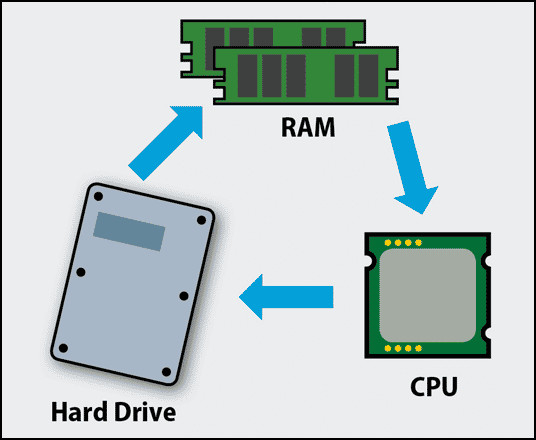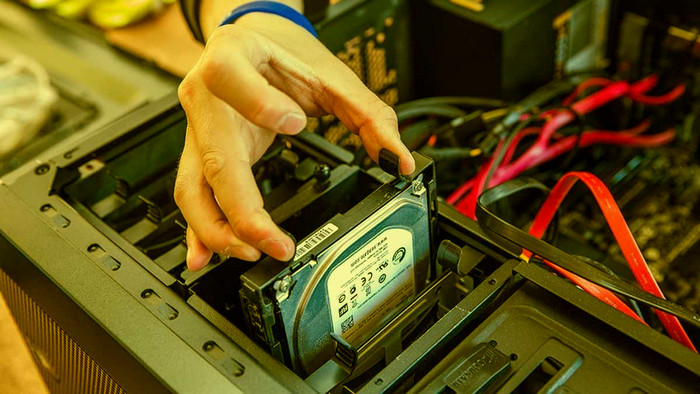A computer is a marvelous machine that connects several components synchronously and still performs without fail.
However, most of the components are not connected to each other.
So, how do they collaborate while performing operations?

Well, this article will answer all your queries.
Can Your CPU Access Hard Disk Directly?
The primary computer architecture restricts the CPU from directly accessing the hard disk.

Instead, it uses itsregistersandmain memory.
So, how does the CPU connect to the motherboard?
The CPU connects to the motherboard via theFSB (front side bus).

The FSB is also known as the speed of the motherboard.
The CPU may useAMD HyperTransportorIntel QuickPathto connect, depending on the motherboard.
Its crystal clear that the CPU cannot directly enter the hard disk because ofCPU architecturallimitations.
There are other reasons for these limitations that I will cover in the next section.
Why Cant a CPU Access a Hard Disk without RAM?
There is no directphysical cable connectionbetween the HDD and the CPU.
That prevents the CPU from directly accessing the hard drives.
Instead, the CPU directly connects to the motherboard via the front side bus.
TheNorthbridge chipsmanage the connection between the CPU and RAM.
Contrarily, theSouthbridge chipsmanage the connections of HDDs.
Another essential thing to consider is thespeed of data.
RAMs are way faster than hard drives, and CPU caches are much faster than RAM.
Usually, the hard drives are slower among all memories used for computing.
The slower data speed of the hard drives isnot perfectly synchronizedwith the high CPU clock speed.
Hence, the CPU cannot directly enter the hard drives.
So, why did we use HDDs instead of RAM?
Because the RAMs are considerably more expensive and cannot store data when turned off.
Therefore, hard drives are more reliable and cost-effective.
The lack ofdirect physical data connectionis another reason that restricts the CPU from accessing the hard drives.
Instead, the CPU directly asks the motherboard for data using the front side bus.
Where the CPU accesses the data in aparallel fashion, hard drives are accessible via serial data.
So, the CPU fails to pull up the data of hard drives directly.
CPU executes all instructions to run any program, but it cannot store the whole program.
Therefore, the CPU needs a storage machine to store the data to access them quickly.
It will be prolonged if the CPU uses a hard disk to store the instruction.
RAM can access any memory address significantly faster at any point.
Accessing the random memory addresses is exceedingly challenging for an HDD compared to the RAM.
The hard disks slower data reading and writing speed will force the CPU to remain idle during the process.
However, SSD can handlerandom memory addressesfar better than HDD.
It is still longer than the RAM.
Thats why the CPU doesnt reach the HDD/SSD to collect or store data.
The controller uses a protocol to communicate with the CPU.
gear driver applications contain the instructions that connect the CPU with the I/O controller.
The operating system is stored in the HDD, and theCPU cant boot without the hard disk.
The process may take a lot of work to understand.
However, consider the following steps to quickly understand how the CPU accesses data from the hard disk.
Here, the I/O controller functions as an intermediary between the CPU and the hard disk.
But, you mustfix the issue with hard disk keeps disconnecting.
Otherwise the CPU wont be able to get into the data stored in the drive.
Frequently Asked Questions
Can CPU access SSD directly?
However, an SSD can dramatically make your gear faster.
Which is directly accessible by the CPU?
The CPU can directly enter the primary memory.
Contrarily, it cannot directly enter the secondary memory.
Can the CPU directly access secondary memory?
A CPU cannot directly access secondary memory.
Instead, the hard disk uses an I/O controller to communicate with the CPU.
When the CPU needs any information, it requests the I/O controller for the data.
Then the I/O controller fetches the data from HDD/SSD and sends it to the CPU using the buffer memory.